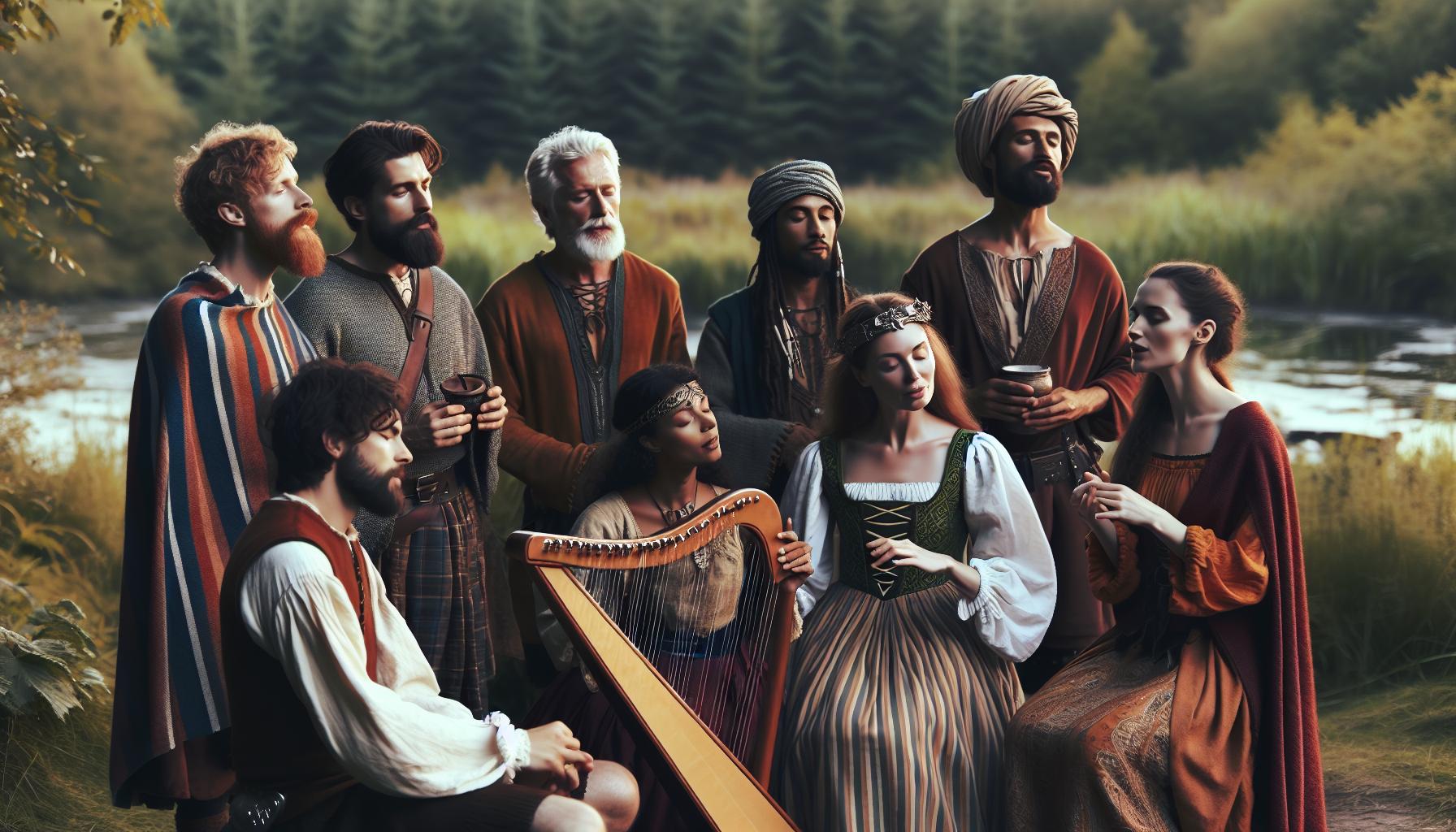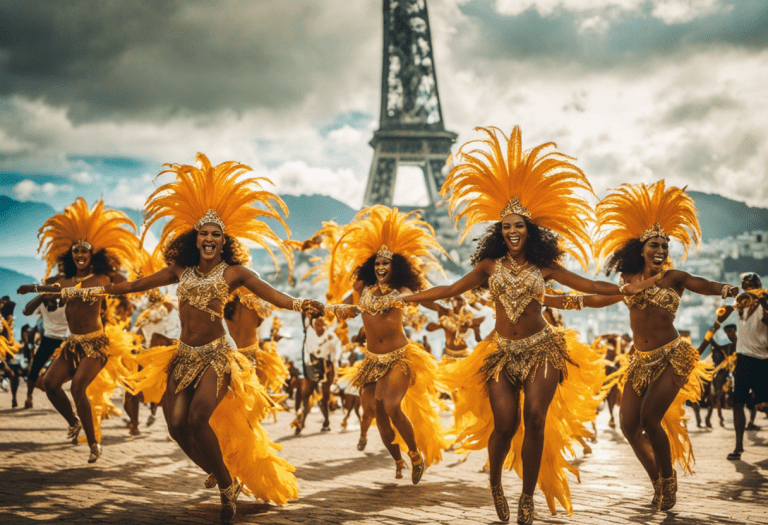Ancient Celtic Chants: Echoes of Aire and Heritage
Imagine stepping back in time to the lush green landscapes of ancient Celtic lands, where the air vibrates with the haunting melodies of ancient chants. These aren’t just songs; they’re a gateway to understanding the rich spiritual and cultural heritage of the Celts.
You’re about to embark on a journey through the mystical world of ancient Celtic chants. You’ll discover their origins, the secrets behind their power, and how they’ve transcended time to enchant modern listeners. Get ready to be captivated by the soul-stirring echoes of history.
Origins of Ancient Celtic Chants
Peering into the mists of time, you’ll find the roots of ancient Celtic chants deeply intertwined with the cultural fabric of the Celts. These chants, or as the Celts called them, “aire”, were more than mere songs; they were a reflection of a society rich in oral tradition and storytelling. Early Druids, the intellectual and spiritual guides of the Celts, employed chants as a tool for preserving history, laws, and ancestral stories before the written word became commonplace.
Understanding the birthplace of these chants requires a journey back to the Iron Age, where Celts flourished across a vast expanse that included today’s United Kingdom, Ireland, and parts of Western Europe. Their chants have survived, albeit fragmented, through the preservation efforts of later generations. An essential aspect of these chants lies in their mode of transmission—passed down verbally from master to apprentice, ensuring each phrase’s original inflection and rhythm remained intact.
These sacred sounds served multiple purposes in Celtic life. Primarily, they were a means of connection with the divine, capable of invoking deep spiritual experiences. During ceremonies and important events, chants were believed to harness the power of nature and the otherworld, bridging the gap between the physical and the metaphysical. Additionally, chants were frequently used for practical purposes, such as healing rites and the blessing of crops, underscoring their integral role in both the mystical and mundane aspects of Celtic existence.
Bards, the revered poets, and musicians of the Celts, played a pivotal role in sculpting the oral landscapes of the times with their mastery in crafting chants. Their performances were not just artful displays of linguistic prowess; they were critical threads in the social tapestry, binding communities with shared histories and values.
Investigating the melodies of these chants, one might stumble upon patterns that mirror the ebb and flow of nature itself. It’s this intricate association with the elements and seasons that further cements the chants’ timeless allure and continues to draw interest from both scholars and enthusiasts alike.
Armed with this knowledge, you might start to sense the pulse of ancient Celtic life beating through their music—an echo of a world where every word and note was steeped in the sacred.
The Power and Significance of Celtic Chants

Ancient Celtic chants, known as “aire”, carried more than just melody; they were the heartbeat of Celtic spirituality and identity. These age-old tunes weren’t just for entertainment; they were a vital tool in keeping history alive and fostering a deep sense of community.
Celtic chants acted as a bridge between the natural and the supernatural, serving as a medium for the Celts to express their reverence for the divine. When you listen to the lilting notes of these chants, consider how they were an integral aspect of sacred rituals and ceremonies. They were believed to possess healing properties and were often used to invoke blessings and protection for the tribe.
Bards, the storytellers and musicians of the Celts, were indispensable in crafting these intricate chants. They were historians, entertainers, and spiritual leaders wrapped into one. With every performance, bards connected their audience to their ancestral roots, enveloping them in the shared memories of their lineage.
In a society where memory and oral tradition were everything, Celtic chants encapsulated these narratives, ensuring they weren’t lost in the mists of time. Their resonant tones mirrored the cadence of the world around them—the rolling hills, the crash of the ocean waves, the whisper of the wind through the trees—allowing listeners to feel at one with their environment.
To truly understand the power of Celtic chants, consider their ability to withstand the test of time. Even now, after centuries have passed, they continue to enchant and inspire. The resilience and allure of Celtic chants speak to their profound impact on Celtic culture.
Recognize the ways in which these ancient melodies have influenced modern music, and how they continue to bring people together, much like they did in the past. The magic of Celtic chants lies in their timeless nature, transcending the ages and still touching souls today.
The Celtic Chanting Tradition

As you delve into the world of ancient Celtic culture, you’ll uncover a rich tradition of chanting—a tradition alive with the echoes of history. These chants, more than mere fragments of a distant past, were the heartbeat of Celtic societies. They served as a vital connection to ancestry, a form of education, and a source of spiritual succor.
Bards, the custodians of chant, wielded their voices as instruments, intertwining melody with the power of word to honor gods and heroes alike. These chants weren’t solely for ceremony; they played a part in everyday life. As the sun rose, chants accompanied the stirring of daily activity; as night fell, they echoed the ending of the day.
The cultural significance of these chants can’t be overstated. They were:
- Oral records of genealogy and history
- Means to pass down tales and traditions
- Methods of connecting with the divine
- Tools to bond the community together
Harnessing the power of rhythm and rhyme, these chants imprinted lessons and lore on the minds of listeners. They transformed complex genealogies and heroic epics into memorable stanzas, enabling them to be shared across generations with ease.
In today’s context, drawing from these ancient practices can enrich your understanding of music and culture. The stirring rhythm of Celtic chants continues to pulse in the veins of contemporary music, from folk to new age genres, reaffirming their timeless appeal.
The durability of this tradition is a testament to its deep roots in the human experience, showcasing how melody and memory can bridge the gap between past and present. The timelessness of Celtic chanting is not just in its ability to survive but in its capacity to adapt and remain relevant, resonating with new audiences while still honoring its ancient origins.
Ancient Celtic Chants in Modern Times

As you look around, influences of Celtic ancestry aren’t just found in history books; they’re alive and thriving in today’s music scene. Ancient Celtic chants, with their deeply resonant melodies, continue to shape contemporary sounds, crossing the barriers of time to impact modern rhythms.
Artists across various genres have sampled the rich textures of ancient Celtic music, blending traditional airs with new-age beats and instruments. You’ll find tracks peppered with the haunting echoes of these chants, giving a nod to a culture that’s steeped in mysticism and earthly roots.
Consider the phenomenal surge in popularity of Celtic music festivals. These events don’t only celebrate the timeless nature of Celtic tunes but also serve as vibrant hubs where past meets present. Enthusiasts from all walks of life gather, united by the evocative power of the chants.
On the theatrical front, shows like “Riverdance” have rocketed the intricate dance and melody of the Celtic world to global acclaim. The traditional percussive rhythms, partnered with the melodic phrases of ancient aire, have mesmerized audiences and demonstrated the chants’ versatility.
Educational programs and documentary series also play a key role in preserving Celtic chants. They bring the mystical allure of old-world songs to a broad audience, sparking interest in exploring one’s lineage or simply offering a deeper understanding of this rich cultural heritage.
Look at how technology aids in this cultural renaissance. Streaming services allow you to access a vast library of Celtic music, including age-old chants that were once passed down orally, now digitized for your convenience. This not only preserves the music but ensures that these powerful oral traditions remain accessible to you, whenever you wish to immerse in their unique soundscape.
Surprisingly, it’s not unusual to uncover the influence of Celtic chants in unexpected places. Take the film industry, for example, where iconic soundtracks leverage the emotive quality of these ancient tunes to enhance cinematic narratives.
The Celtic spirit, once thought to be confined to the mist-shrouded past, finds fresh breath in modern times. The transcendent nature of these ancient chants is a testament to their durability, continually adapting and resonating with new audiences and musicians.
Exploring the Enchanting World of Celtic Chants

As you delve deeper into Celtic culture, you’ll find yourself entranced by the allure of ancient Celtic chants. These chants, or “aire” as they’re traditionally known, carry the weight of centuries; they’re far more than mere melodies echoing through the halls of time.
Bards and musicians tirelessly sculpted these chants, each note a thread in the intricate tapestry of Celtic heritage. These sounds served more than entertainment – they encapsulated the spirit of the people and their stories. It’s said that the very essence of Celtic life vibrates within these chants.
Imagine standing amidst a lush, green landscape, the mist clinging to the hills; the sound of a Celtic chant resonates, its haunting melody drifting on the breeze. You can feel the connection – the bond – that music forges through time and space, linking you to those who once stood where you stand.
Much of what is known about Celtic society comes from these lyrical narratives. Their chants were as much historical documents as they were works of art, preserving the warriors’ bravery, the chieftains’ lineage, and the land’s sacred tales. These oral records were crucial in a time before written language was widespread, ensuring the survival of Celtic culture through relentless waves of change.
The rhythmic patterns and melodies of Celtic chants have an uncanny way of stirring something profound within you. Whether it’s the particular arrangement of notes or the often nature-inspired rhythms, they evoke an immediate and visceral response. This isn’t just music. It’s a key to understanding a rich, enigmatic past that refuses to be forgotten.
Even today, these ancient chants influence modern melodies and rhythms, their echoes heard in genres as diverse as folk to new age to rock. Musicians might add their unique twist, but the core – that timeless allure of the Celtic spirit – remains untouched by the passing of eras.
Technology has played its part in keeping these chants alive, making them accessible to those who may never set foot on Celtic soil. Through apps, online platforms, and digital libraries, the possibility to immerse yourself in this enchanting musical heritage is just a click away, waiting to be unearthed by eager ears and open hearts.
Conclusion
You’ve journeyed through the mystical realm of ancient Celtic chants and uncovered their deep-rooted significance. These aire, far more than mere melodies, are the threads that weave the fabric of Celtic history and community. They’re a testament to the power of oral tradition and its ability to transcend time, resonating with hearts and souls across generations. You now understand the profound impact these chants have had, not only in their own era but also in shaping contemporary music and culture. With technology’s help, they’re reaching an even broader audience, ensuring that the enchanting echoes of the Celts will continue to inspire and connect us for years to come. Embrace the melodies that have captured the essence of a people and let them transport you to an age where music was the heartbeat of a vibrant culture.







